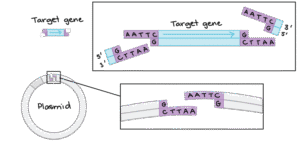Back to: MICROBIOLOGY 500 LEVEL
Welcome to class!
My ever-curious science genius, welcome once again! I love how committed you are to growing your microbiology knowledge. Today, we’re going into a topic that feels like science fiction but is very real and powerful. Imagine having special scissors and glue in a lab that lets you cut and paste DNA just like editing a document. That’s exactly what restriction enzymes and DNA ligase help scientists do. Let’s break it down in a simple, human way you can connect with.
Restriction Enzymes And Dna Ligase
Imagine you’re doing a group project, and each person has written a part of the report. But you need to cut some sections and paste them together neatly into one final document. In the lab, scientists do the same thing with DNA—cutting pieces they need and joining them in useful ways. The tools they use are called restriction enzymes (cutters) and DNA ligase (joiners).
Restriction Enzymes (Molecular Scissors)

Restriction enzymes, also known as restriction endonucleases, are special proteins that cut DNA at specific sequences.
These enzymes are naturally found in bacteria, where they serve as defence tools against viruses by cutting up invading viral DNA.
Each restriction enzyme recognises a specific DNA sequence (often palindromic, meaning the sequence reads the same forwards and backwards) and cuts at or near that site.
Example:
The enzyme EcoRI recognises the sequence GAATTC and cuts between G and A.
When it cuts, it often leaves “sticky ends”—short, single-stranded overhangs that can easily pair with matching DNA.
It’s just like using a pair of tailor’s scissors to cut fabric along a dotted line—clean and precise.
DNA Ligase (Molecular Glue)
Once you’ve cut DNA with restriction enzymes, you might want to join it to another piece of DNA—this is where DNA ligase comes in.
DNA ligase is an enzyme that seals the gap between two DNA fragments by forming a bond between their sugar-phosphate backbones.
It’s like using glue to join two puzzle pieces perfectly so they become one smooth piece again.
Real-life Nigerian example: Think of a mechanic in Enugu fixing a broken fuel pipe—he cuts off the damaged part and seals a new piece using strong tape or glue. That’s exactly what restriction enzymes and DNA ligase help us do with DNA in the lab.
Why Are They Important?
They are essential in genetic engineering, cloning, and biotechnology.

Scientists use them to insert genes (like insulin-producing genes) into bacteria, which then produce the protein.
They are also used in creating genetically modified organisms (GMOs), DNA fingerprinting, and medical research.
Summary
- Restriction enzymes cut DNA at specific sequences.
- DNA ligase joins DNA fragments by sealing breaks in the sugar-phosphate backbone.
- These tools are used in genetic engineering, cloning, and modern biotechnology.
Evaluation
- What is the function of a restriction enzyme?
- Why is DNA ligase important in genetic engineering?
- Give one example of how restriction enzymes are used in real-world science.
Bravo, superstar! You’ve just unlocked one of the most powerful tools in modern molecular biology. The ability to cut and join DNA is what allows scientists to fight diseases, produce medicine, and improve food. And now, you understand how it works! Keep showing up for yourself—Afrilearn is here to help you become a change-maker through knowledge. See you in the next lesson!
